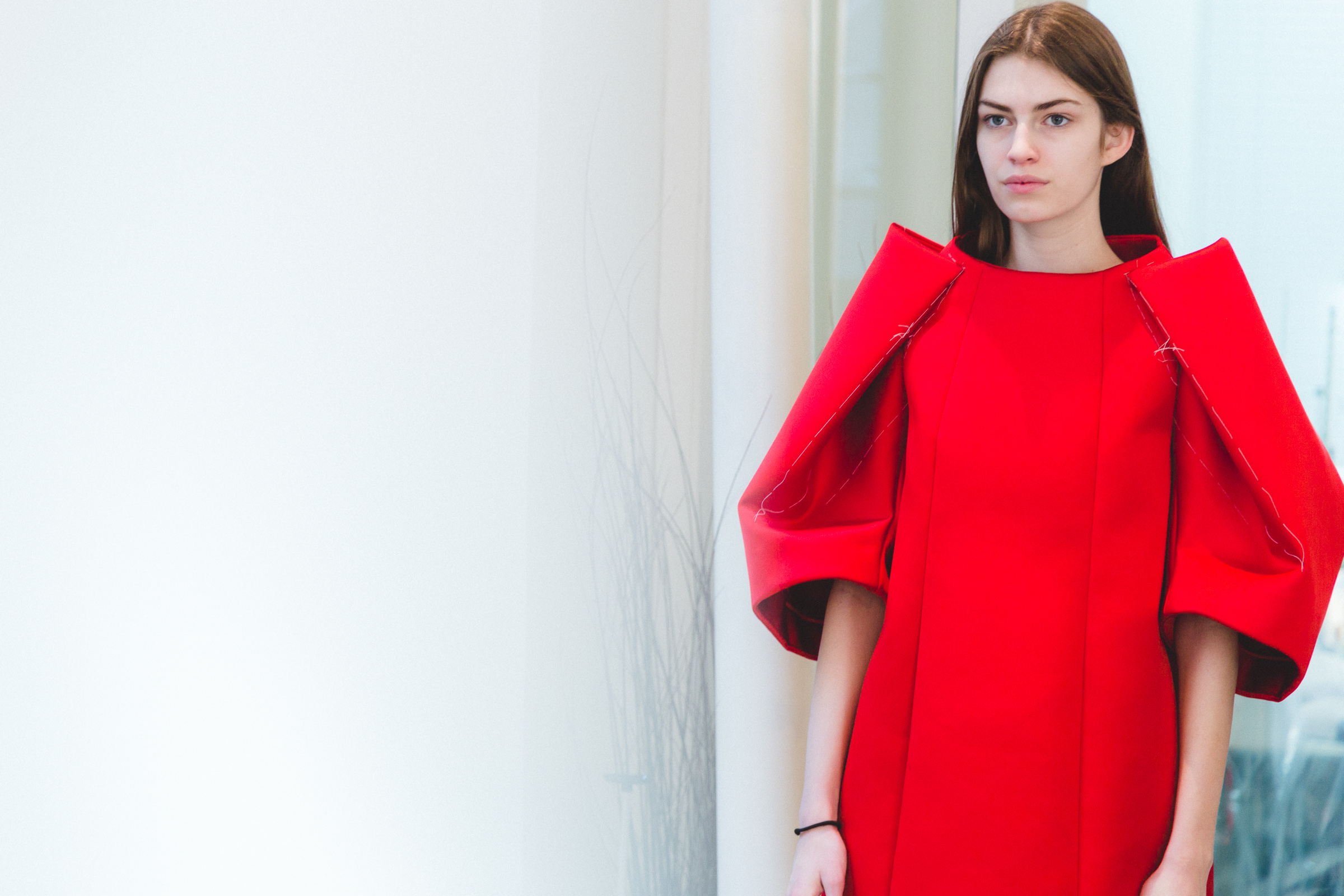An Interview with Dice Kayek
A rummage through old toys from Ece Ege’s childhood provided a starting point for the creative director’s latest Spring/Summer 2015 couture collection for Dice Kayek. Thus a spinning top became a short baby-doll dress with multi-color silk Mikado (a blend of silks that results in a heavier fabric — perfect for the designer’s architectural constructions), and a 1980s video game, Tetris, inspired a dress with a patchwork of embroideries, antique blown glass beads and crystals as if “falling from the sky.”
But beyond the apparent innocence of the designs also lay a disturbing subtext as Paris-based Turkish designer revealed how she had been inspired by the more troubling works of Hans Bellmer with his hypersexual dolls, Annette Messager and her disarticulated dolls, and Louise Bourgeois’ fetish dolls. Embracing the concept of “deconstructing to reconstruct,” which can be seen in some of these artist’s works, Ege sent models down the runway in elegant baby-doll dresses that played on the idea of assemblage of different elements giving little twists to her designs.
“My inspiration came really from an accumulation of things I’d seen,” the designer says, adding that she first saw the artworks of Bellmer seven years ago and “was intrigued by his life and his artistic expression. Then I saw the illustrations he did for Paul Éluard’s book in 1949, Les Jeux de La Poupee (The Games of the Doll), it was so advanced for the time, so twisted — in a beautiful way.
He ‘decomposed’ to ‘recompose’ something else, and that’s the process that I really wanted to explore,” she says, adding, “I didn’t want to just do something asymmetric; that’s not interesting enough. I wanted to take a garment, ‘deconstruct’ it and completely ‘recompose’ it to create something new. That’s why you can see in the collection several outfits, like a white gabardine (that’s) half a dress and half a jacket.”
The petite designer admits, with a laugh, she loves things many would find disturbing. Though she’s quick to point out her own childhood was “very beautiful.”
Folding to create creases and accentuate volumes was the key to her “Dollhouse” collection, continuing on a theme developed in her first couture collection last July, which immediately established the experienced designer as a new couture voice to be listened to and revealed her vision of youthful, rather minimalist contemporary couture based on structured volumes using beautiful fabrics like silk, satin and crepes.
Ege and her sister Ayse Ege, who runs the business, set up the Dice Kayek brand in Paris in 1992 focusing on ready-to-wear and over the years, the fashion house has won accolades for the architectural sensibility of its designs. In 2013, three pieces from its Istanbul Contrast collection, which evoked Istanbul’s architectural heritage, won the Victoria & Albert Museum’s Jameel Prize III, an international award for contemporary art and design inspired by Islamic traditions — one of these dresses, an angel-winged evening coat hand-embroidered with antique blown glass beads brought to mind the Hagia Sophia Mosque and is now in the permanent collection of the museum.
“Architecture is always my inspiration,” Ege says, admitting a preference for Frank Gehry’s buildings. “I like architecture’s timelessness and its solidity. I don’t like fluidity, or anything frivolous. There are a lot of strong foundations under each couture garment; certain things may appear very simple, the fabric may appear like it’s just holding on its own, but I can assure you there is nothing simple about it.”
For her Tetris dress, which has two sharp folds at its front, Ege reached out to an architecture student, the son of one of her pattern makers, to help her think in 3D. The solution was to create padded triangle forms to help push the fabric forward and hold it in place.
“I’ve always loved couture,” Ege says, acknowledging that after 22 years in fashion she has grown increasingly interested in construction and perfection — “although it’s never perfect” — and she wanted to give a new outlet to her creativity while taking on a new challenge: “Couture is so difficult, but it’s so artistic. Couture should be more intelligent than ready-to-wear, and it challenges me to explore another side. Of course, ready-to-wear is the backbone of a fashion company, you need it to be able to stand on your two feet, but with couture, I can run free.”
Dice Kayek’s first couture collection for Fall/Winter 2014, “Winter Garden,” explored the organic world of flowers in a highly structured way with dramatically-shaped dresses that offered an autumn bouquet of femme-fleurs (flower women). Outfits were named after flowers and the designer twisted and molded duchesse satin to create forms resembling petals, stamens and calyxes, with pleated organza adding some transparent texture and lightness while small, sparkling glass beads were sometimes included to evoke morning dew.
For the “Dollhouse” collection, the designer cocooned her silhouettes with sculpted dresses, capes and capelets, while also paying special attention to sleeves, with striking exaggerated volumes. “I practically don’t draw for couture; it’s mostly work on the dummy, draping like a sculpture,” she said, adding that she deliberately chooses color blocks to put the accent on her constructions.
Ege says she aims to create ageless designs, tasteful and with soul, which will remain loved for years to come, and she’s keen to create “couture that is easy to wear.”
“Today, couture clients are getting younger and I believe they would love to wear something short and elegant, more girlish and romantic. It’s important to do young haute couture; young in terms of energy.”
AS FIRST PUBLISHED IN BLOUIN LIFESTYLE'S APRIL EDITION




